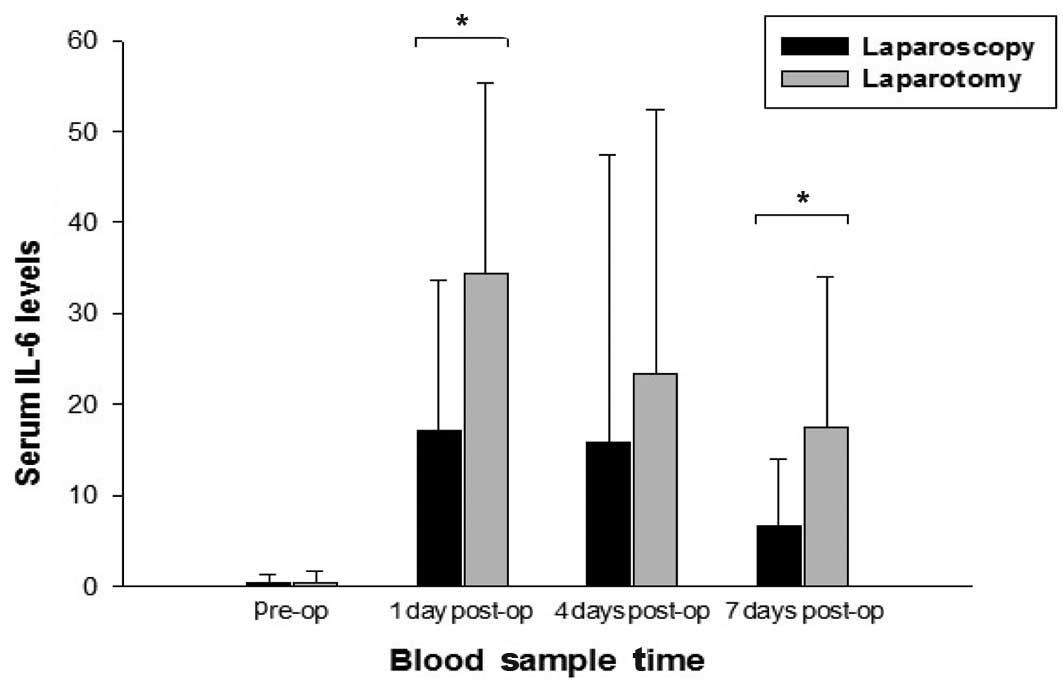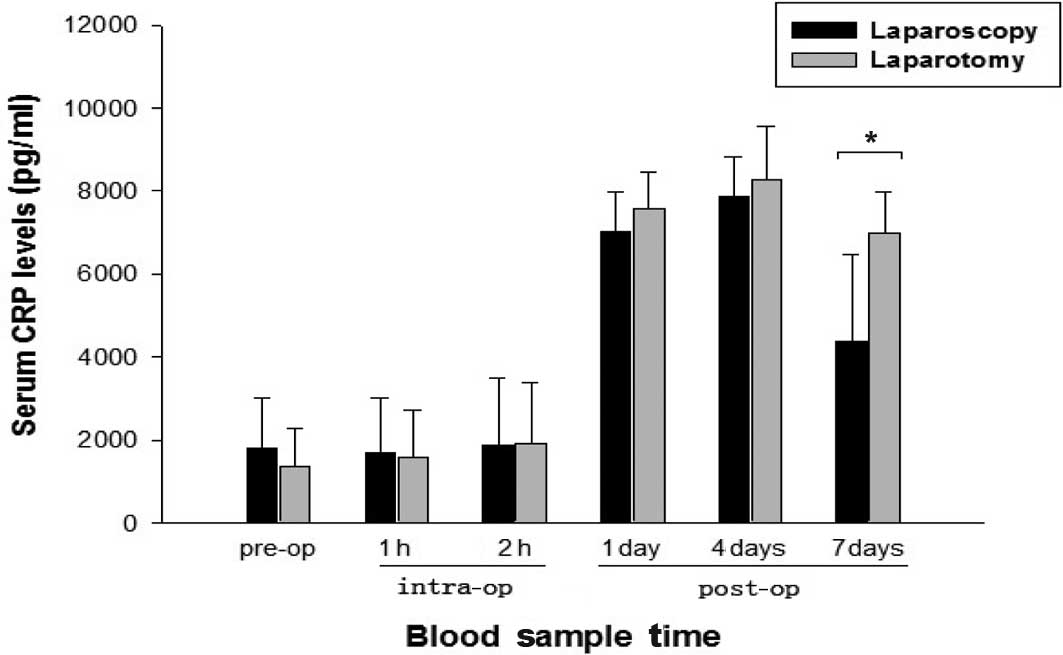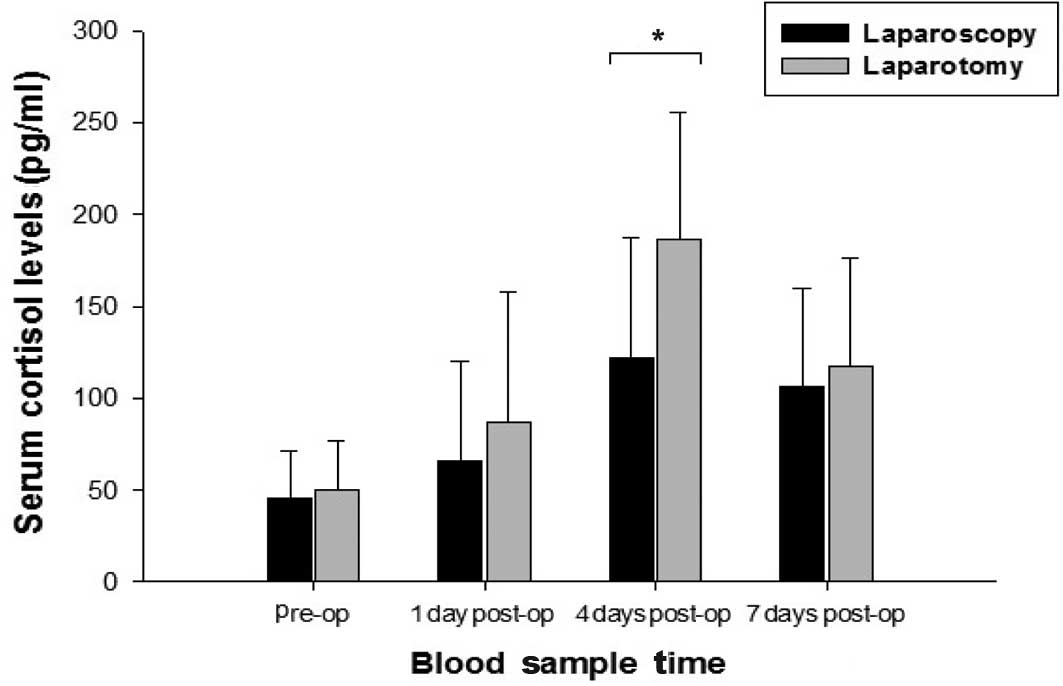|
1
|
Querleu D, Leblanc E and Castelain B:
Laparoscopic pelvic lymphadenectomy in the staging of early
carcinoma in the cervix. Am J Obstet Gynecol. 164:579–581. 1991.
View Article : Google Scholar : PubMed/NCBI
|
|
2
|
Dargent D and Mathevet P: Radical
laparoscopic vaginal hysterectomy. J Gynecol Obstet Biol Reprod.
21:709–710. 1992.PubMed/NCBI
|
|
3
|
Querleu D: Laparoscopically assisted
radical vaginal hysterectomy. Gynecol Oncol. 51:248–254. 1993.
View Article : Google Scholar : PubMed/NCBI
|
|
4
|
Roy M: Laparoscopically assisted vaginal
radical hysterectomy. Best Pract Res Clin Obstet Gynaecol.
19:377–86. 2005. View Article : Google Scholar
|
|
5
|
Morgan DJ, Hunter DC, McCracken G, et al:
Is laparoscopically assisted radical vaginal hysterectomy for
cervical carcinoma safe? A case control study with follow up. BJOG.
114:537–542. 2007. View Article : Google Scholar : PubMed/NCBI
|
|
6
|
Jackson KS, Das N, Naik R, et al:
Laparoscopically assisted radical vaginal hysterectomy vs. radical
abdominal hysterectomy for cervical cancer: a match controlled
study. Gynecol Oncol. 95:655–61. 2004. View Article : Google Scholar
|
|
7
|
Steed H, Rosen B, Murphy J, et al: A
comparison of laparascopic-assisted radical vaginal hysterectomy
and radical abdominal hysterectomy in the treatment of cervical
cancer. Gynecol Oncol. 93:588–593. 2004. View Article : Google Scholar : PubMed/NCBI
|
|
8
|
Malur S, Possover M and Schneider A:
Laparoscopically assisted radical vaginal versus radical abdominal
hysterectomy type II in patients with cervical cancer. Surg Endosc.
15:289–292. 2001. View Article : Google Scholar : PubMed/NCBI
|
|
9
|
Sharma R, Bailey J, Anderson R, et al:
Laparoscopically assisted radical vaginal hysterectomy
(Coelio-Schauta): A comparison with open Wertheim/Meigs
hysterectomy. Int J Gynecol Cancer. 16:1927–1932. 2006. View Article : Google Scholar : PubMed/NCBI
|
|
10
|
Nam JH, Kim JH, Kim DY, et al: Comparative
study of laparoscopico-vaginal radical hysterectomy and
abdominalradical hysterectomy in patients with early cervical
cancer. Gynecol Oncol. 92:277–283. 2004. View Article : Google Scholar : PubMed/NCBI
|
|
11
|
Kohler C, Klemm P, Schau A, et al:
Introduction of transperitoneal lymphadenectomy in a gynecologic
oncology center: analysis of 650 laparoscopic pelvic and/or
paraaortic transperitoneal lymphadenectomies. Gynecol Oncol.
95:52–61. 2004. View Article : Google Scholar
|
|
12
|
Hertel H, Kohler C, Michels W, et al:
Laparoscopic-assisted radical vaginal hysterectomy (LARVH):
prospective evaluation of 200 patients with cervical cancer.
Gynecol Oncol. 90:505–511. 2003. View Article : Google Scholar : PubMed/NCBI
|
|
13
|
Lee CL, Huang KG, Jain S, et al:
Comparison of laparoscopic and conventional surgery in the
treatment of early cervical cancer. J Am Assoc Gynecol Laparosc.
9:481–487. 2002. View Article : Google Scholar : PubMed/NCBI
|
|
14
|
Dargent D and Mathevet P: Schauta’s
vaginal hysterectomy combined with laparoscopic lymphadenectomy.
Baillieres Clin Obstet Gynaecol. 9:691–705. 1995.
|
|
15
|
Allendorf JDF, Bessler M, Kayton ML,
Oesterling SD, Tret MR, Nowygrod R and Whelan RL: Increased tumor
establishment and growth after laparotomy vs laparoscopy in a
murine model. Arch Surg. 130:649–653. 1995. View Article : Google Scholar : PubMed/NCBI
|
|
16
|
Mutter D, Hajri A, Tassetti V, Solis-Caxaj
C, Aprahamian M and Marescaux J: Increased tumor growth and spread
after laparoscopy vs laparotomy. Surg Endosc. 13:365–370. 1999.
View Article : Google Scholar : PubMed/NCBI
|
|
17
|
Renaud MC, Plante M and Roy M: Combined
laparoscopic and vaginal radical surgery in cervical cancer.
Gynecol Oncol. 79:59–63. 2000. View Article : Google Scholar : PubMed/NCBI
|
|
18
|
Spirtos NM, Eisenkop SM, Schlaerth JB, et
al: Laparoscopic radical hysterectomy (type III) with aortic and
pelvic lymphadenectomy in patients with stage I cervical cancer:
surgical morbidity and intermediate follow-up. Am J Obstet Gynecol.
187:340–348. 2002. View Article : Google Scholar
|
|
19
|
Puntambekar SP, Palep RJ, Puntambekar SS,
et al: Laparoscopic total radical hysterectomy by the Pune
technique: our experience of 248 cases. J Minim Invasive Gynecol.
14:682–689. 2007. View Article : Google Scholar : PubMed/NCBI
|
|
20
|
Salo M: Effects of anaesthesia and surgery
on the immune response. Acta Anaesthesiol Scand. 36:201–220. 1992.
View Article : Google Scholar : PubMed/NCBI
|
|
21
|
Bolla G and Tuzzato G: Immunologic
postoperative competence after laparoscopy vs laparotomy. Surg
Endosc. 17:1247–1250. 2003. View Article : Google Scholar : PubMed/NCBI
|
|
22
|
Gupta A and Watson DI: Effect of
laparoscopy on immune function. Br J Surg. 88:1296–1306. 2001.
View Article : Google Scholar : PubMed/NCBI
|
|
23
|
Lennard TW, Shenton BK, Borzotta A, et al:
The influence of surgical operations on components of the human
immune system. Br J Surg. 72:771–776. 1985. View Article : Google Scholar : PubMed/NCBI
|
|
24
|
Cruickshank AM, Fraser WD, Burns HJ, van
Damme J and Shenkin A: Response of serum interleukin-6 in patients
undergoing elective surgery of varying severity. Clin Sci.
79:161–165. 1990.PubMed/NCBI
|
|
25
|
Gebhard F, Pfetsch H, Steinbach G, et al:
Is interleukin 6 an early marker of injury severity following major
trauma in humans? Arch Surg. 135:291–295. 2000. View Article : Google Scholar : PubMed/NCBI
|
|
26
|
Stensballe J, Christiansen M, Tonnesen E,
et al: The early IL-6 and IL-10 response in trauma is correlated
with injury severity and mortality. Acta Anaesthesiol Scand.
53:515–521. 2009. View Article : Google Scholar : PubMed/NCBI
|
|
27
|
Holub Z: Impact of laparoscopic surgery on
immune function. Clin Exp Obstret Gynecol. 29:77–81.
2002.PubMed/NCBI
|
|
28
|
Harkki-Siren P, Sjoberg J, Toivonen J and
Tiitinen A: Clinical outcome and tissue trauma after laparoscopic
and abdominal hysterectomy: a randomized controlled study. Acta
Obstet Gynecol Scand. 79:866–871. 2000.PubMed/NCBI
|
|
29
|
Malik E, Buchweitz O, Muller-Steinhardt M,
et al: Prospective evaluation of the systemic immune response
following abdominal, vaginal, and laparoscopically assisted vaginal
hysterectomy. Surg Endosc. 15:463–466. 2001. View Article : Google Scholar
|
|
30
|
Yuen PM, Mak TW, Yim SF, Kee WD, et al:
Metabolic and inflammatory responses after laparoscopic and
abdominal hysterectomy. Am J Obstet Gynecol. 179:1–5. 1998.
View Article : Google Scholar : PubMed/NCBI
|
|
31
|
Baigrie RJ, Lamont PM, Kwiatkowski D, et
al: Systemic cytokine response after major surgery. Br J Surg.
79:757–760. 2000. View Article : Google Scholar
|
|
32
|
Leung KL, Lai PB, Ho RL, et al: Systemic
cytokine response after laparoscopic-assisted resection of
rectosigmoid carcinoma: a prospective randomized trial. Ann Surg.
231:506–511. 2000. View Article : Google Scholar
|
|
33
|
Jeschke MG, Wolf SE, DebRoy MA and Herndon
DN: The combination of growth hormone with hepatocyte growth
factors alters the acute phase response. Shock. 12:181–187. 1999.
View Article : Google Scholar : PubMed/NCBI
|
|
34
|
Gabay C and Kushner I: Acute-phase
proteins and other systemic responses to inflammation. N Engl J
Med. 340:448–454. 1999. View Article : Google Scholar : PubMed/NCBI
|
|
35
|
Faist E and Wichmann MW: Immunology in the
severely injured. Chirurg. 68:1066–1070. 1997.PubMed/NCBI
|

















